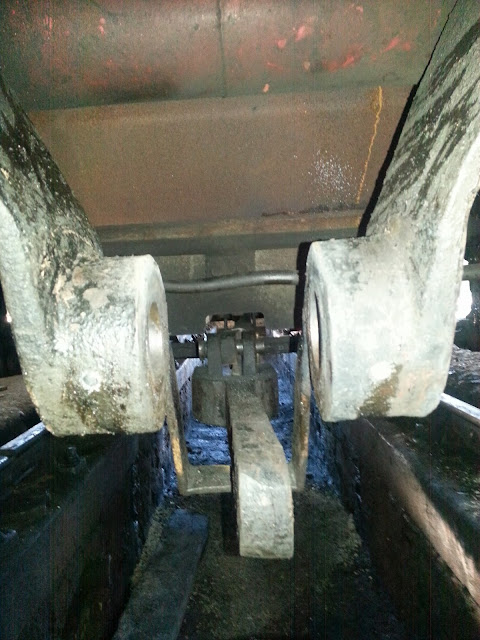It's been a busy time with 828 since the last update on the blog. We've had her in steam twice to check out various repairs and also had the Trustees of the CR828 Trust, the legal owners of the loco, at Aviemore for their AGM. Not all of the Trustees could make the journey to the far North and those who did expressed their satisfaction with the work that has been carried out on the loco. At the AGM Ian Stanworth, SRA Chairman, was elected as a Trustee. The SRA has been very consistent over many years in providing financial support to 828 and it seems fitting that the SRA Chairman should be a Trustee.
John Greig has been making and fitting more new and improved worsted trimmings to the motion parts - he has made them to give an increased rate of oil flow to ensure adequate lubrication for the new bearings on the big ends and eccentrics. Once the loco is run-in the flow can be reduced.
The oak planks donated by the National Trust for Scotland courtesy of Aidan Bell at Inverewe Gardens have been marked out and cut roughly to size as the new wooden packing for the front buffers. Final machining is being undertaken by a neighbour of Keith Holyland in Auldearn. The finished spacers will be fitted shortly.
Some time was spent recently adjusting the loco brakes. It can be fairly said that the loco steam brakes have never contributed a great deal to the stopping power of the engine. The tender steam brake has always seemed to provide most of the brake power. I discussed this several years back with the late William Peaston who had driven members of the 812 Class in BR days when he was a Driver at Greenock Ladyburn Shed. His recollection was that the steam-braked locos were better 'stoppers' than the Westinghouse air braked versions. He was therefore surprised that we found 828 to be a poor 'stopper'. We may have uncovered the reason for this. BR removed the Westinghouse air brakes from 828 in the mid-1950s and fitted the steam brake that we have today. When the loco was steamed last week it was partly to test the brake following adjustment. The result was disappointing; there was a great deal of leakage past the brake piston and the brakes were very slow to release. A decision was therefore taken to remove the brake cylinder from under the dragbox and strip it for a full examination. This revealed that one of the two piston rings was too tight in the cylinder due to lack of ring gap clearance. The gap was adjusted and the piston, which had been very difficult to move, became a very good sliding fit in the cylinder. We also found that the bellcrank lever that transmits the force from the brake piston to the brake pull rods had seized on its pivot pin and required excessive force to make it move. With something of a struggle the pin was freed and the bellcrank removed. With everything cleaned up we decided to fit grease injection points to the bushings to prevent this problem recurring. The Caley had provided an oil hole in the bellcrank but this was found plugged with coal dust and no oil had penetrated to the pin for a long time..
Colin Vaughan has been pressing Rileys for an update on delivery of the correctly sized tender tyres. As before, the order has to be placed via West Coast Railway Company Ltd. Rileys have been pressing them for an update but none is available thus far. Hopefully we will hear something before the end of November..
 |
| Looking smart outside the Shed and getting ready for another steam test on 11th November.. |
 |
| In flight...! Nathan Lightowler demonstrates 828 in action for the CR828 Trustees at their AGM on 12th November.. |
 |
| CR828 Trust Chairman, Jim Spy climbs aboard the Trust's loco on 12th November. Some other guy gets into the picture too.. |
 |
| John Greig fitting new trimmings to the RH Big End on 11th November.. |
 |
| Roddie McRae with a wheelbarrow load of oak planks and one of the old spacers for the front buffers.. |
 |
| Marking out for cutting the oak to size.. |
 |
| Roddie McRae putting a coat of paint on the new LH Driving Hornblock.. |
 |
| It's a heavy lump...! Roddie McRae removes the nuts while Colin Vaughan and Calum Titley take the weight of the cylinder.. |
 |
| Safely landed on the Shed floor we can see the piston peeping coyly out of the cylinder and very reluctant to move.. |
 |
| Colin Vaughan admires the upturned cylinder... |
 |
| Piston stripped for inspection on the bench in the Shed fitting shop.. |
 |
| Reassembled with both piston rings now having the same gap clearance when fitted in the cylinder |
 |
| Colin Vaughan applying some heat to help remove the brake bellcrank pivot pin.. |
 |
| The pivot pin driven almost completely out... |
 |
| The refurbished brake cylinder awaiting refitting to the loco.. |
 |
| Brake piston rod top-end rebushed by Nathan Lightowler.. |
 |
| Tapping out the bellcrank for a grease nipple to assure correct lubrication of the pivot pin. |
 |
| Job done - grease nipples fitted to the bellcrank and the brake piston rod pin.. |
 |
| Under the loco drilling and tapping the bellcrank hanger bushes for grease nipples.. |
 |
| Bellcrank back in place and lubrication assured... |
 |
| Low sunlight on a very cold Autumn day (18th November) catches 828 as she watches 46512 outside in the Shed yard getting ready for a test run.... |


No comments:
Post a Comment
Note: only a member of this blog may post a comment.